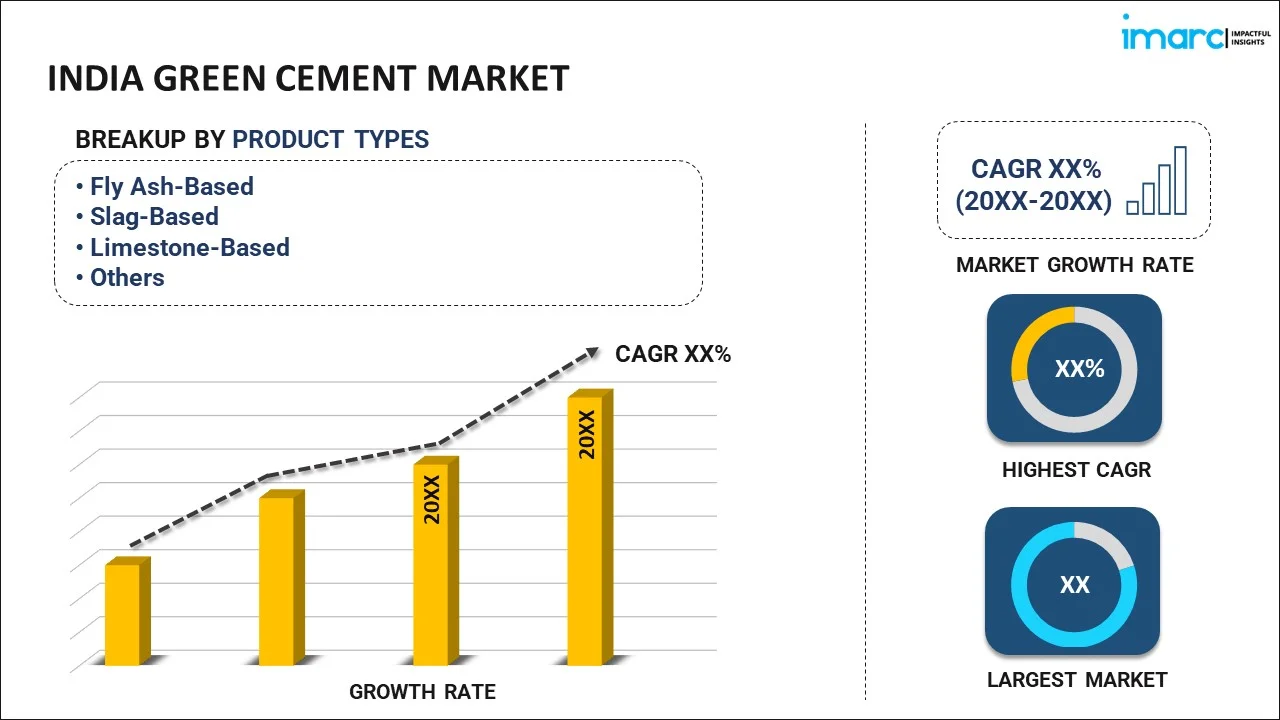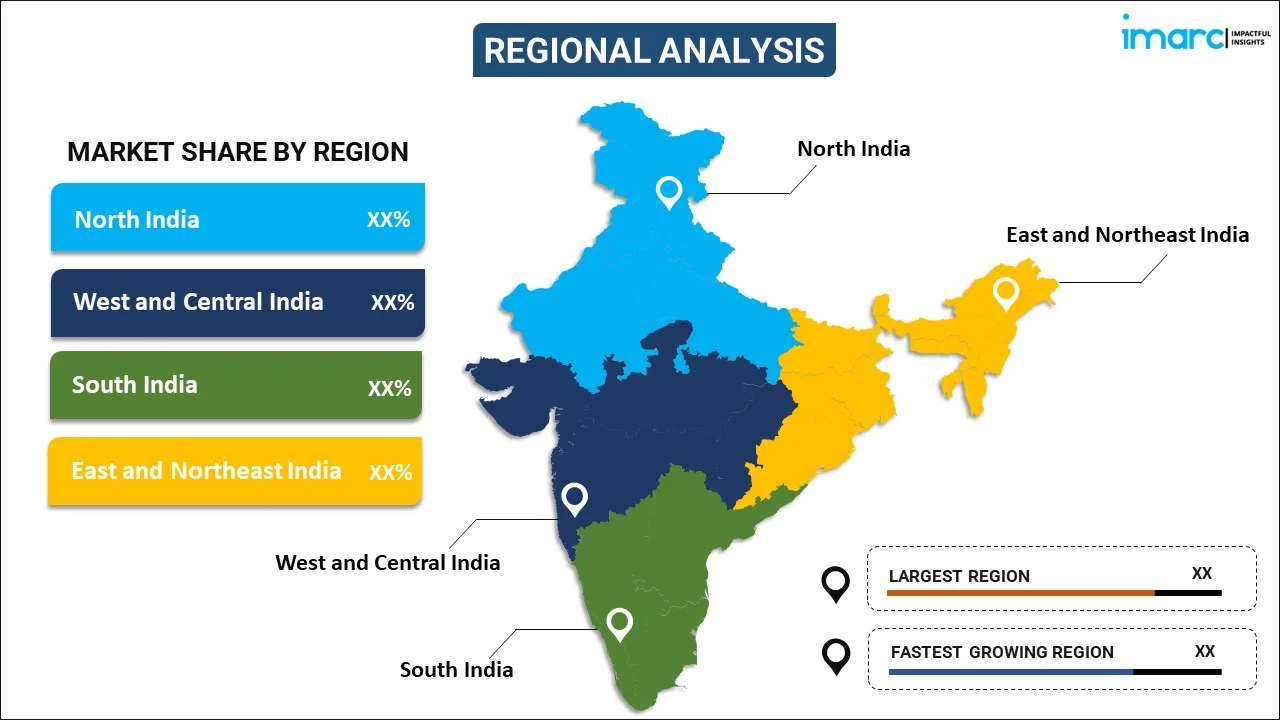
India Green Cement Market Report by Product Type (Fly Ash-Based, Slag-Based, Limestone-Based, Silica Fume-Based, and Others), End Use Industry (Residential, Non-Residential, Infrastructure), and Region 2025-2033
Market Overview:
India green cement market size reached USD 1.6 Billion in 2024. Looking forward, IMARC Group expects the market to reach USD 2.8 Billion by 2033, exhibiting a growth rate (CAGR) of 6.11% during 2025-2033. The increasing use of alternative raw materials, such as fly ash, slag, and other industrial byproducts, in the production of green cement, which reduces the reliance on traditional materials like limestone and clay, is driving the market.
|
Report Attribute
|
Key Statistics
|
|---|---|
|
Base Year
|
2024 |
|
Forecast Years
|
2025-2033
|
|
Historical Years
|
2019-2024
|
| Market Size in 2024 | USD 1.6 Billion |
| Market Forecast in 2033 | USD 2.8 Billion |
| Market Growth Rate (2025-2033) | 6.11% |
Green cement refers to environmentally friendly alternatives to traditional Portland cement, which is a major contributor to carbon dioxide emissions in the construction industry. Unlike conventional cement production that relies on high-temperature kilns and releases substantial carbon dioxide, green cement incorporates sustainable materials and innovative manufacturing processes. Common substitutes include fly ash, slag, and silica fume, by-products of other industries, reducing the demand for raw materials. Additionally, some green cement formulations absorb carbon dioxide during their curing process, offsetting emissions. The adoption of green cement aligns with efforts to mitigate climate change and reduce the environmental impact of construction activities. As the construction sector seeks sustainable practices, green cement offers a promising solution to lower the carbon footprint associated with traditional cement production.
India Green Cement Market Trends:
The green cement market in India is experiencing substantial growth, driven by a confluence of factors that underscore the regional shift toward sustainable construction practices. Firstly, heightened environmental awareness has propelled the demand for eco-friendly building materials. Consequently, the escalating concerns about the carbon footprint associated with traditional cement production have prompted a surge in the adoption of green alternatives. Furthermore, stringent government regulations mandating reduced emissions and increased use of sustainable materials in construction projects have catalyzed the market's expansion. Moreover, technological advancements in cement production have played a pivotal role in shaping the green cement landscape. Innovations such as the use of alternative raw materials and novel manufacturing processes have not only enhanced the environmental credentials of cement but also contributed to cost efficiency, appealing to a broader market. Additionally, the growing recognition of green buildings and sustainable infrastructure as key components of corporate social responsibility has incentivized businesses to prioritize environmentally friendly construction materials, thereby boosting the green cement market. In essence, the confluence of environmental consciousness, regulatory imperatives, technological innovations, and a shifting corporate ethos collectively propels the green cement market forward in India, signaling a transformative era in the construction industry.
India Green Cement Market Segmentation:
IMARC Group provides an analysis of the key trends in each segment of the market, along with forecasts at the country level for 2025-2033. Our report has categorized the market based on product type and end use industry.
Product Type Insights:

- Fly Ash-Based
- Slag-Based
- Limestone-Based
- Silica Fume-Based
- Others
The report has provided a detailed breakup and analysis of the market based on the product type. This includes fly ash-based, slag-based, limestone-based, silica fume-based, and others.
End Use Industry Insights:
- Residential
- Non-Residential
- Infrastructure
A detailed breakup and analysis of the market based on the end use industry have also been provided in the report. This includes residential, non-residential, and infrastructure.
Regional Insights:

- North India
- West and Central India
- South India
- East and Northeast India
The report has also provided a comprehensive analysis of all the major regional markets, which include North India, West and Central India, South India, and East and Northeast India.
Competitive Landscape:
The market research report has also provided a comprehensive analysis of the competitive landscape in the market. Competitive analysis such as market structure, key player positioning, top winning strategies, competitive dashboard, and company evaluation quadrant has been covered in the report. Also, detailed profiles of all major companies have been provided.
India Green Cement Market Report Coverage:
| Report Features | Details |
|---|---|
| Base Year of the Analysis | 2024 |
| Historical Period | 2019-2024 |
| Forecast Period | 2025-2033 |
| Units | Billion USD |
| Scope of the Report | Exploration of Historical Trends and Market Outlook, Industry Catalysts and Challenges, Segment-Wise Historical and Future Market Assessment:
|
| Product Types Covered | Fly Ash-Based, Slag-Based, Limestone-Based, Silica Fume-Based, Others |
| End Use Industries Covered | Residential, Non-Residential, Infrastructure |
| Regions Covered | North India, West and Central India, South India, East and Northeast India |
| Customization Scope | 10% Free Customization |
| Post-Sale Analyst Support | 10-12 Weeks |
| Delivery Format | PDF and Excel through Email (We can also provide the editable version of the report in PPT/Word format on special request) |
Key Questions Answered in This Report:
- How has the India green cement market performed so far and how will it perform in the coming years?
- What has been the impact of COVID-19 on the India green cement market?
- What is the breakup of the India green cement market on the basis of product type?
- What is the breakup of the India green cement market on the basis of end use industry?
- What are the various stages in the value chain of the India green cement market?
- What are the key driving factors and challenges in the India green cement?
- What is the structure of the India green cement market and who are the key players?
- What is the degree of competition in the India green cement market?
Key Benefits for Stakeholders:
- IMARC’s industry report offers a comprehensive quantitative analysis of various market segments, historical and current market trends, market forecasts, and dynamics of the India green cement market from 2019-2033.
- The research report provides the latest information on the market drivers, challenges, and opportunities in the India green cement market.
- Porter's five forces analysis assist stakeholders in assessing the impact of new entrants, competitive rivalry, supplier power, buyer power, and the threat of substitution. It helps stakeholders to analyze the level of competition within the India green cement industry and its attractiveness.
- Competitive landscape allows stakeholders to understand their competitive environment and provides an insight into the current positions of key players in the market.
Need more help?
- Speak to our experienced analysts for insights on the current market scenarios.
- Include additional segments and countries to customize the report as per your requirement.
- Gain an unparalleled competitive advantage in your domain by understanding how to utilize the report and positively impacting your operations and revenue.
- For further assistance, please connect with our analysts.
 Inquire Before Buying
Inquire Before Buying
 Speak to an Analyst
Speak to an Analyst
 Request Brochure
Request Brochure
 Request Customization
Request Customization




.webp)




.webp)












